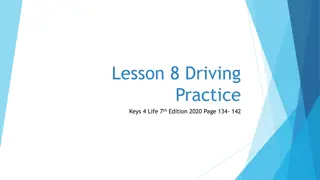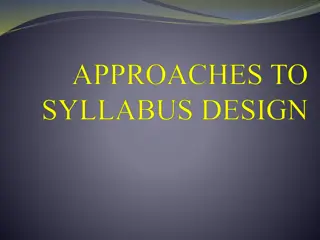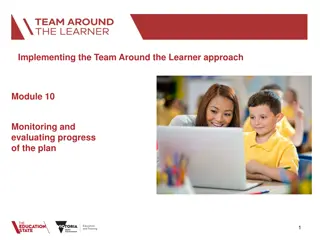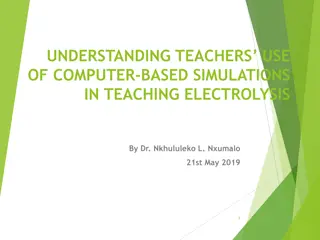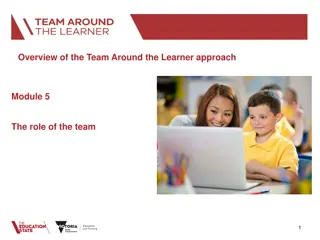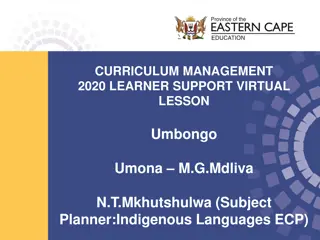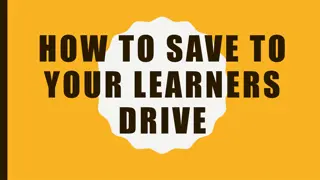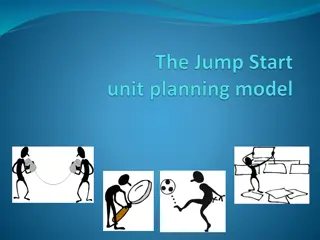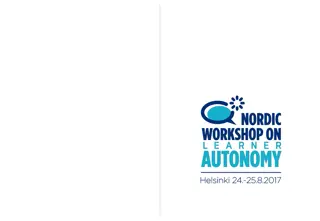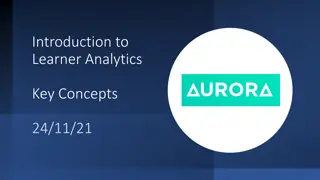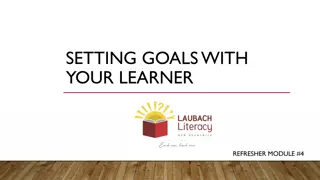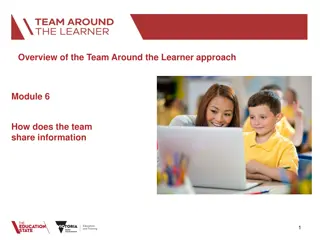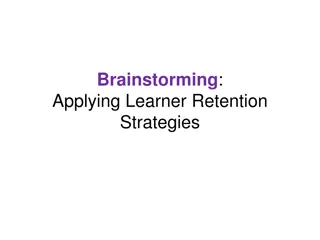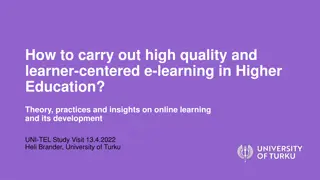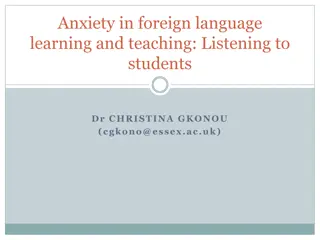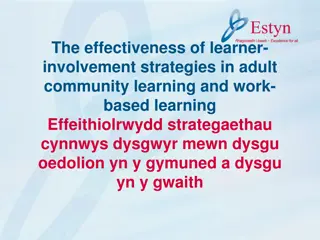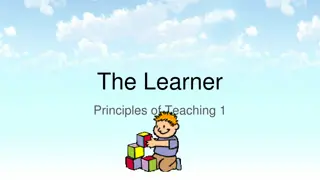Enhancing Language Learning Through Learner Training Strategies
This comprehensive webinar equips participants with the ability to recognize, understand, and utilize various forms of Language Training (LT) strategies, ultimately enabling them to confidently implement these practices in the classroom. Learner training is emphasized as a means to foster independent and effective language learners by encouraging responsibility for learning, developing learning strategies, and promoting reflection on the learning process.
Uploaded on Sep 25, 2024 | 0 Views
Download Presentation

Please find below an Image/Link to download the presentation.
The content on the website is provided AS IS for your information and personal use only. It may not be sold, licensed, or shared on other websites without obtaining consent from the author.If you encounter any issues during the download, it is possible that the publisher has removed the file from their server.
You are allowed to download the files provided on this website for personal or commercial use, subject to the condition that they are used lawfully. All files are the property of their respective owners.
The content on the website is provided AS IS for your information and personal use only. It may not be sold, licensed, or shared on other websites without obtaining consent from the author.
E N D
Presentation Transcript
AS A RESULT OF THIS WEBINAR, PARTICIPANTS WILL BE ABLE TO: Recognize the various forms and functions of LT Understand the benefits of strategy instruction Use LT to solve common classroom problems Feel confident implementing LT practices in their classrooms
ACCORDING TO THE BRITISH COUNCIL LT involves helping learners find out how they learn most effectively. It means encouraging learners to take responsibility for learning and helping them to develop learning strategies and study skills. Most importantly, it asks learners to reflect on how they are learning. The aim of learner training is to produce effective, independent language learners.
ACCORDING TO THE BRITISH COUNCIL LT involves helping learners find out how they learn most effectively. It means encouraging learners to take responsibility for learning and helping them to develop learning strategies and study skills. Most importantly, it asks learners to reflect on how they are learning. The aim of learner training is to produce effective, independent language learners.
KEY TERMS Take responsibility for learning Independence in language use Develop learning strategies Tools to help learners learn Ask learners to reflect Encourage learners to think about what they doing and how they are progressing
POTENTIAL TEACHER ROLES Supportive Caretaker- A person who nurtures and aids in growth Captivating Performer- A person who leads from the front through entertainment and intrigue All-knowing Master- A person who imparts his/her expert knowledge onto others Admired Older Sibling- A person who is looked up to because of what he/she has accomplished
Teaching is nothing more than showing someone that something is possible (http://iteslj.org/Techniques/McCarthy-Autonomy.html)
COGNITIVE LEARNING STRATEGIES Techniques, actions, and behavior that learners employ to aid their learning and understanding Flash cards Vocabulary journal Mnemonic devices Note taking Highlighting Graphic organizer Jazz chant Repetition
METACOGNITIVE AWARENESS Learning styles and preferences
LEARNING STYLES Learning Styles
METACOGNITIVE AWARENESS Learning styles and preferences Multiple intelligences
METACOGNITIVE AWARENESS Learning styles and preferences Multiple intelligences Self-assessment
WHY IS LT BENEFICIAL? Increased self-efficacy The perceived ability of a person to successfully complete a task Increased learner autonomy Taking control of your own learning through heightened metacognitive awareness and self-confidence
COMPONENTS OF LT Learning about yourself Learning independently Learning from each other Self-reflection
LEARNING ABOUT YOURSELF Allow students to discover and maximize their personal learning styles and preferences Metacognitive quiz (VARK) Diverse forms of input Freedom of expression in production tasks
LEARNING BY YOURSELF Encourage learners to develop their own cognitive strategies and resources Flash cards Vocabulary journal Mnemonic devices Interaction with text (highlighting and notetaking) Language reference materials (dictionary, thesaurus, corpus, forums)
MNEMONIC DEVICES A rhyme, acronym, or association used to help you remember Differentiate Spanish demonstratives ese (that) and este (this) This and these have the Ts Recalling the countries of CentralAmerica My Goodness Eating Hot Nachos Causes Pain: Mexico, Guatemala, El Salvador, Honduras, Nicaragua,Costa Rica, Panama Remembering the colors of the rainbow ROY G. BIV: Red, Orange, Yellow, Green, Blue, Indigo, Violet
DICTIONARIES WITH FORUMS http://www.wordreference.com/
DICTIONARIES WITH FORUMS http://www.wordreference.com/
CORPUS-REAL WORLD EXAMPLES http://www.linguee.com/
LEARNING FROM EACH OTHER- CLASSMATES Provide opportunities for cooperative learning Think, pair, share Pair and small group work Task and project-based learning
LEARNING FROM EACH OTHER- TEACHER Be explicit about your teaching Explain why you do what you do Your approach to teaching and learning Be a good role model State goals and expectations Ask for feedback
LEARNING FROM YOURSELF Demand critical reflection to give lessons personal and real world meaning Journal (private or dialogue) Self-assessment questionnaires Identify motivation Ask your student to think about why they study English Goal setting
SAM PLE COU RSE OUT LINE Week Theme Monday Tuesday Course syllabus and rules Thursday VAK quiz and strategies Friday Teacher hot seat Scategories 1 Gettingready to learn Letters to yourself Cheeseburgerin Paradise WhyEnglish? Find someone who Newlywedgame Unit 1: Food from the Earth Vocabulary Assessment Food comics Literacy skills: vocabulary from context 2 Food history jigsaw Food vocabulary Extensive reading Culture research project Presentations Literacy skills: summary 3 Unit 2: Communication Cross-cultural communication Jigsaw reading Extensive reading Literacy skills: Genre awareness Unit 3: Cities Jigsaw reading 4 Introduction to cities,vocabulary Jinancity guide Extensive reading Literacy skills: Elements of stories Unit 4: The Body 5 Bodyvocabulary, lifestyles, Aliments and remedies Illness research report Grammar: comparatives Writing skills Peer review Extensive reading
SAMPLE COURSE OUTLINE Week Theme Monday Tuesday Course syllabus and rules Thursday VAK quiz and strategies Friday Teacher hot seat Scategories Gettingready to learn 1 Letters to yourself Cheeseburgerin Paradise Find someone who Newlywedgame WhyEnglish? Unit 1: Food from the Earth Vocabulary Assessment Food comics 2 Literacy skills: vocabulary from context Food history jigsaw Food vocabulary Extensive reading Culture research project Presentations 3 Unit 2: Communication Cross-cultural communication Literacy skills: summary Jigsaw reading Extensive reading Unit 3: Cities Jigsaw reading 4 Introduction to cities,vocabulary Jinancity guide Literacy skills: Genre awareness Extensive reading Literacy skills: Elements of stories Unit 4: The Body Body vocabulary, lifestyles, Aliments and remedies Illness research report 5 Grammar: comparatives Peer review Writing skills Extensive reading
COMMON PROBLEMS How could LT help solve these common problems that students express about their learning experiences?
PROBLEM #1 How could you use LT to address this problem? I just started studying English, and it s so difficult. How can I be expected to remember so many new words? Type your ideas in the chat box
PROBLEM #3 How could you use LT to address this problem? Type your ideas in the chat box
How could you use LT to address this problem? Type your ideas in the chat box
A WORD OF ADVICE Practice what you preach Be patient Use your resources Colleagues Professional publications Professional organizations
REFERENCES British council: Teaching English. Retrieved March 12, 2017 from https://www.teachingenglish.org.uk/article/learner-training. Demola, S. & Steingraeber, M. (2012). Learning how to learn:A new way of thinking and doing. School Forum, 4 (11), 4. Hsueh, Shanlan. (2016). Chineasy. Retrieved from: http://www.chineasy.com/. Kumaravadivelu, B. (2003). Beyond methods: Macrostrategies for language teaching. New Haven: Yale University Press. Lehtonen, T. (2000).Awareness of strategies is not enough: How learners can give each other the confidence to use them. LanguageAwareness, 9, 64- 77. McDevitt, B. (1997). Learner autonomy and the need for learner training. Language Learning Journal, 16, 34- 39. Oxford, R. (1994). Language learning strategies:An update. CAL Online Resources: Digests. Schunk, D. H. (1991). Self-efficacy and academic motivation. Educational Psychologist, 26, 201- 231. van Lier, L. (2007). Action-based teaching, autonomy and identity. International Journal of Innovation in Language Learning and Teaching, 1, 46- 65. VARK Learn Limited. (2017). VARK: A guide to learning styles. Retrieved from: http://vark-learn.com/.



